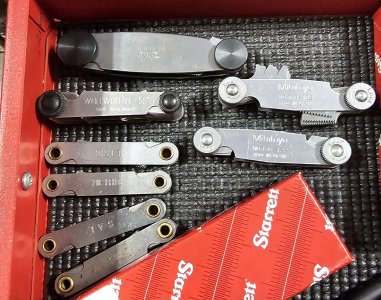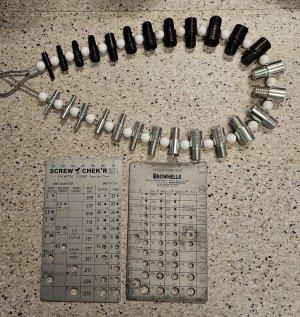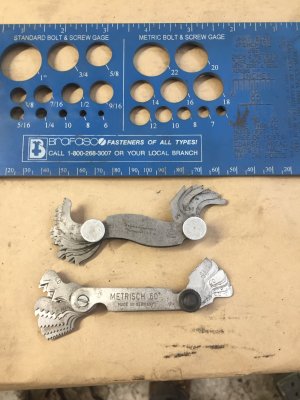My process is pretty much like yours, Sus, but I try the various "Thread Checker" sets I have before delving into MH.
Actually, I do that too. I have a few different thread checkers I like. The top four are my working set, but I have some nice ones in the house too.

I also love the metric and imperial screw checkers below. But they only work for small screws. I recently got a necklace from Ali and I like it too for bigger fasteners. It's sort of like the ones at the fastner stores but easier to store in a home shop. Mine just hangs on a nail.

I don't really have a problem with the really big stuff. They are almost always sorta obvious.
You remind me that I asked for a process but didn't volunteer my own for criticism. Given the regular problems I have, maybe that's how I should have started this thread.
1. Attempt to identify the pitch with thread gauges, counting teeth under a magnifying glass, or sometimes like my caliper repair, under a microscope. Sometimes hold the thread up to a tap if you have one with the right pitch. Write down the possibilities as it's not always obvious and if I don't write it down I'll forget and have to start over.
2. Measure the OD or ID and subtract a wee bit for thread crest and valley based on the pitch size - more for big threads. Compare to the obvious threads on the wall chart, in threading tables, and as a last resort in MH.
Use thread wires or a thread Mic on external threads along the lines of what
@PeterT suggested above. Curse at internal ones. Here is where
@fixerup's wooden dowel will keep the air from turning black and blue in my neck of the woods. (Ya, I love that idea!) Thinking it might work on hard to reach external threads too by screwing a wooden tube on and off, and then sectioning it.....
If the thread is not common or obvious, I make a sample gauge screw or gauge hole to test fit. Often, that means buying a tap and die (like this time).
On very rare occasions, I have calculated how many threads it takes to be out one complete thread and then measured over that length. This z-axis thread might be one of those times.
I've not had good success watching YouTube or searching the internet. Generally, I find that those kind of threads are easy peasy anyway. It's the rare, unusual, and custom threads that drive me crazy. I encountered a custom thread on a BXA tool holder of all places a year ago or so. Drove me bonkers! I made a copy by single point threading, and it worked, but why the hell would they do that to us! That must have cost them money to do!



